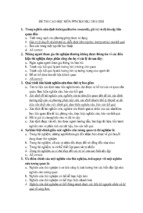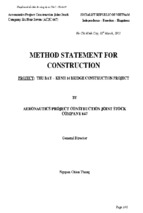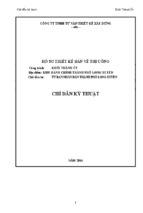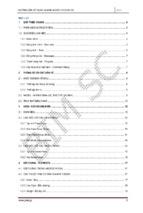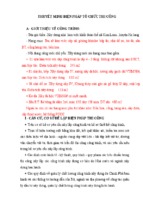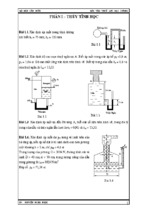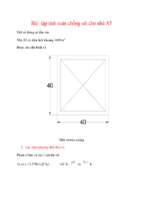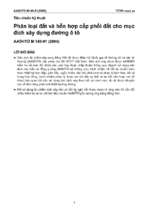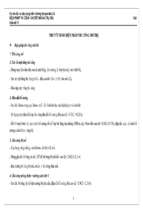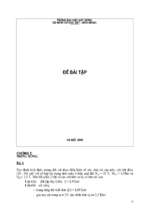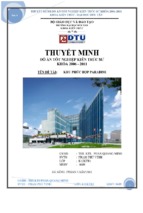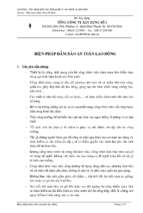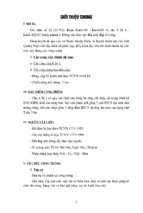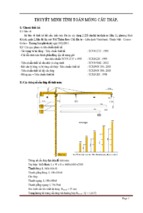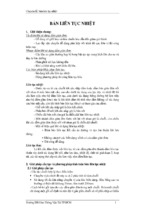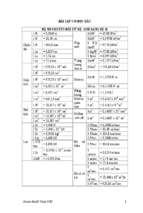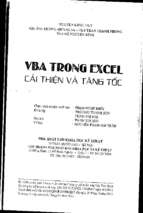đề cương thi công và đầm thử nghiệm bê tông asphalt lớp đệm và lớp mặt tuyến cao tốc Nội Bài - Lào Cai
MISTRY OF TRANSPORT
NOI BAI-LAO CAI HIGHWAY PROJECT
PACKAGE A7 : KM 190+420 TO KM 218+040
BỘ GIAO THÔNG VẬN TẢI
DỰÁN XÂY DỰNG ĐƯỜNG CAO TỐC NỘI BÀI - LÀO CAI
GÓI THẦU A7: KM 190+420 TO KM 218+040
CONSTRUCTION OUTLINE AND TRIAL COMPACTION OF ASPHALT
CONCRETE BINDER COURSE AND SURFACE COURSE
ĐỀ CƯƠNG THI CÔNG VÀ ĐẦM THỬ NGHIỆM BÊ TÔNG ASPHALT
LỚP ĐỆM VÀ LỚP MẶT
REF / TÀI LIỆU SỐ:GRBCC-MS-AC-A1-EN-VN
THE CONTRACTOR/ NHÀ THẦU
GENTINSA INGENIERIA S.L- RESIDENT
ENGINEER / KỸ SƯ THƯỜNG TRÚ
LIANG ZHE
MOHAMED A.KOBBI
Date/ Ngày
09/2012
Revision/ Bản
A1
Purpose/ Mục đích
Submission for approval
Prepared by/ Chuẩn bị bởi
Liang Zhe
COMMENT
I. Outiline.
II. Equipment.
III.Material.
1. Bituminius prime coat.
2. Bituminius tack coat.
3. Bituminous plant – Mix material – Asphalt conrete.
IV.Construction.
A. Produce asphalt concrete.
1. Preparation of Bitumen Binder Material.
2. Preparation of Aggregates.
3. Mixing.
B. Trial of asphalt concrete binder course.
1. Preparation of surface.
2. Construction of bituminus prime coat.
3. Tranporting.
4. Spreading.
5. Compaction.
6. Sampling for testing.
7. Informing result of trial compaction.
C. Trial of asphalt concrete surface course.
1. Preparation of surface.
2. Construction of bituminus tack coat.
3. Tranporting.
4. Spreading.
5. Compaction.
6. Sampling for testing.
7. Informing result of trial compaction.
I. Outline.
-
This method statement describes the sequence of produce asphalt concrete and spread and
compacted trial on site construction.
-
It is applicable for asphalt concrete binder course and asphalt concrete surface course.
-
The purpose of the trials is to determine and establish the rolling patterm and type of rollers /
compactors to be used in placing the asphalt concrete on the pavement.
II. Equipement.
-
List of equipement to be used for construction Asphalt concrete is as follow:
No
Equipment
Description
Quantity
1
1 each
2
Distribution
1 each
3
Bituminous
batching plant
4
Trucks
5
Bituminous pavers
1 each
6
Steel wheeled rollers (
8T
tow wheel )
1 each
7
Pneumatic typred rollers
16T
1 each
8
-
Blower
Steel wheeled rollers ( 3
12T
wheel )
Remark
1 each
concrete
Station Km195+900
1 each
15~20T
4 each
Equipment used for construction of bituminous pavement shall comply with Specification of project
– Section 05200 – Pavement structure.
III. Material.
1. Bituminius prime coat.
-
Bituminous material.
Bituminous material shall be of type and grade shall conform to the requirements of the specification
listed below:
+ Medium – curing cut back asphalt:
AASHTO M 82
+ Rapid – curing cut back asphalt : AASHTO M 81
-
The grade and temperatures at spreading at C is medium-curing cut back asphalt MC-70 ( spreading
temperature is from 43-85oC ) of rapid-curing cut back asphalt RC-250 ( spreading temperature is
60-100oC ).
-
Blotter Material.
Blotter material shall be approved clean, dry sand or stone screenings free from any cohesive
material. It shall contain no organic matter.
2. Bituminous tack coat.
-
Bituminous material shall conform to the requirements of the Specification listed below:
Rapid-curing cut back asphalt: AASHTO M81
-
The grade and the temperatures for spreading is rapid-curing cut back shall be RC-250 (60 – 100oC).
3. Bituminous plant – Mix material – Asphalt conrete.
a) Composition of mixtures.
-
The asphalt concrete shall be comform the following index of retained strength as determined in
accordance with AASHTO T245.
Description
Surface and binder cousre
Stability : N
Flow : mm
Voids in total mix : %
9000 min.
2.5 – 4.0
3-5
Voids filled with Asphalt: %
-
75 ~ 85
The several aggregate and filler fractions for the mixture shall be sized, graded, and combined in
such proportions that the resulting composite blend meets one of the grading requirements of the
table below.
-
Grade B shall be used for asphalt concrete binder course.
-
Grade C shall be used for asphalt concrete surface course.
Grade of aggregate
Sieve Designation
Percentage Passing by Weight
(mm)
Grade B
Grade C
50.0
-
-
37.5
-
-
25.0
100
-
19.0
95 - 100
100
12.5
68 - 86
95 - 100
9.5
56 - 78
74 - 92
4.75
38 - 60
48 - 70
2.36
27 - 47
33 - 53
1.18
18 - 37
22 - 40
0.600
11 - 28
15 - 30
0.300
6 - 20
0.075
10 - 20
0-8
4
-9
b) Coarse aggreate.
-
The coarse aggregate (retained on the 2.36 mm sieve) shall consist of clean, tough, durable
fragments free from an excess of flat, elongated, soft or disintegrated pieces and free from stone
coated with dirt or other objectionable material. The percentage of wear when tested according to
AASHTO T96, shall be as follows:
-
Los Angeles Abrasion:
* For use in asphalt concrete binder and surface course - not more than 25% loss.
-
The sodium sulphate soundness loss shall not exceed 9 percent and the magnesium sulphate
soundness loss shall not exceed 12 percent.
c) Fine aggreate .
-
The fine aggregate (passing a 2.36 mm sieve), shall have General Characteristics and Soundness in
accordance with AASHTO M29 but the loss shall not exceed 25%.
d) Filler .
-
Mineral filler, when required, shall consist of limestone dust, portland cement or other non-plastic
mineral matter from sources approved by the Engineer. Mineral filler shall be dry, free flowing, free
from lumps and other objectionable material and when tested by means of laboratory sieve, shall
meet the following gradation requirements:
Sieve Designation (mm)
Percentage Passing by Weight
0.600
100
0.180
95 – 100
0.075
65 – 100
e) Biumen binder.
-
Normal Bitumen: Bitumen material shall be cement class AC-20 (equivalent to needle penetration
60/70pen, compliance with AASHATO requirements in AASHTO M 226. Other asphalt materials
shall be used only after the Engineer’s approval.
-
Normal Bitumen: Bitumen material shall be cement having needle penetration of 60/70, compliance
with requirements in “Standard for solid bitumen” 22TCN279-01. Other asphalt materials shall be
used only after the Engineer’s approval.Yêu cầu chỉ tiêu Bitum (Tham chiếu bảng 1 của 22TCN27901)
Bitumen properties Requirement (referred table 1 of 22TCN279-01)
No.
Properties
Unit
Grade 60/70
1
Penetration at 250C
0.1mm
60 – 70
Equivalent Testing method
22TCN279-
ASTM D5
01
AASHTO T49
Min. 100
22TCN27901
ASTM D113
AASHTO T151
0
46 - 55
22TCN27901
AASHTO T5389
0
C
Min. 230
22TCN27901
ASTM D92
2
Ductility at 250C
3
Softening point (ring and ball
method)
4
Flash point
5
Loss on heating for 5 hours at
1630C
%
Max. 0.8
22TCN27901
6
Ratio of penetration of residue
after heating for 5 hours at 1630C
to one at 250C
%
Min. 75
22TCN27901
7
Solubility in Trichloroethylene
C2CL4
%
Min. 99
22TCN27901
8
Specific gravity at 250C
g/cm3
1 – 1.05
22TCN27901
9
Effect of water on bituminous –
coated aggregate using boiling
water
grade
Min. 3rd grade
22TCN27901
ASTM D3625
10
Wax paraffin content
%
Max. 2.2
22TCN27901
DIN-52015
cm
C
AASHTO T48
ASTM D6
AASHTO T47
ASTM D6/D5
ASTM D2042
AASHTO T44
ASTM D70
AASHTO T228
IV. Construction.
A- Produce asphalt concrete .
1. Preparation of Bitumen Binder Material.
-
The bitumen binder material shall be heated to a temperature of between 140oC and 160oC. Heating
shall be carried out in such a manner that avoids any local overheating and provides a continuous
supply of the material to the mixer at a uniform temperature at all times. Bitumen shall not be used
while it is foaming nor shall it be heated above 170oC at any time.
2. Preparation of Aggregates.
-
Aggregates for the mixture shall be dried and heated to a temperature between 140oC and 170oC.
Flames used for drying and heating shall be properly adjusted to avoid damage to the aggregates and
to avoid soot on the aggregate. Immediately after heating and drying, aggregates shall be screened
into three or more compartments ready for batching and mixing with the heated bitumen binder.
-
When the bitumen binder and filler are added, the temperature of the aggregates as introduced into
the mixer shall not exceed that at which the asphalt cement has a Saybolt Furol viscosity of 100
seconds, determined by AASHTO T72. It shall not be lower than is required to obtain complete
coating and uniform distribution of the aggregate particles and to provide a mixture of satisfactory
workability.
3. Mixing.
-
The dried aggregate shall be combined in the mixer in the amount of each fraction of aggregates
required to meet the job-mix formula. The bitumen binder shall be measured or gauged and
introduced into the mixer in the amount specified by the job-mix formula.
-
After the required amounts of aggregate, bitumen and filler have been introduced into the mixer,
unless otherwise specified, the materials shall be mixed until a complete and uniform coating of the
particles and a thorough distribution of the bituminous material throughout the aggregate is secured.
Wet mixing time will be determined by the Engineer for each plant and for each type of mix and
aggregate used.
-
For plant mix bituminous pavement, the mixture shall be produced as closely as practicable to the
lowest temperature that will produce a workable mix within the specified temperature range, taking
into account current weather conditions and the haul distance to the point of use.
B- Trial of asphalt concrete binder course.
1. Preparation of surface.
-
Location of trial: Km196+500 to Km196+590
-
Area of trial: Lenght 90m, wide 3.5m
-
Immediately before applying the bituminous material all loose dirt and other objectionable material
shall be removed from the surface with a power broom and/ or blower as required. If the Engineer so
orders, the surface shall be lightly bladed and rolled immediately prior to the application of
bituminous material, in which case brooming or blowing will not be required. When so ordered by
the Engineer a light application of water shall be made just before the application of bituminous
material. The area to be treated shall be approved by the Engineer prior to application.
-
Fixing location and level preading on edge of road.
2. Construction of bituminus prime coat.
-
Weather limitations : Prime coat shall be applied only with the approval of the Engineer who will
specify the grade to be used. The surface to be treated shall be dry or slightly damp, and the
atmospheric temperature in the shade above 13oC and rising or above 15oC if falling.
-
Application of Bituminous Material: Bituminous material shall be applied to the width of the section
to be primed by means of a bitumen distributor in a uniform, continuous spread. The rate of
application will usually be in the range of 1.0 to 2.5 kg/sq.m. and the Engineer will determine the
rate and material grade to be used for each material being covered.
-
Application of Blotter Material: In order to minimize possible damage by rain before the surface has
completely dried, the Engineer may instruct that blotter material should be spread to cover any wet
bituminous material. Blotter material shall be spread so that no wheels or tracks will travel on
uncovered wet bituminous material.
3. Transporting.
-
The mixture shall be transported from the mixing plant to the point of use in vehicles. No loads shall
be sent out so late in the day as to prevent completion of the spreading and compaction of the
mixture during daylight hours unless with the Engineers approval and satisfactory illumination is
provided.
-
Vehice body shall be close. Vehice transporting asphalt concrete shall be tarpaulin.
-
Each vehicle shall be weighed after each loading at the mixer and a record shall be kept of the load ID
number, gross weight, tare, net weight, and time of day of each load operation. The mixture shall be
delivered to the point of use at a temperature between 125oC and 160oC.
-
Before pouring asphalt concrete into asphalt pavers, shall be check the temperature of the mixture
with a thermometer, if the temperature mixture below 120oC, must be removed.
4. Spreading and finishing.
-
The mixture shall be laid upon an approved surface, spread and struck off to the grade and elevation
established. Bituminous pavers shall be used to distribute the mixture on trials section 2.5x30m. The
start and finish point of each load/ batch shall be marked on the edge of the pavement in a manner as
directed by the Engineer.
-
The Contractor shall carry out such tests as are necessary to determine the uncompacted thickness of
mixture to be laid for compaction to conform to the required finished depths. The uncompacted
material immediately behind the paver shall then be measured at frequent intervals and adjustments
made to ensure conformity with the nominal depths.
-
Thick of asphalt concrete binder course are 10cm, so we diveded into 2 layer, thick of one layer are
5cm.
5. Compaction.
-
After the bituminous mixture has been spread, passed requirement of cross fall and elevation,
carrying out to compact overall surface by approved equipments. Compacting follow approach
sequence below:
-
Initial : use steel weeled rolled ( 2 weeled ) weighing 8T, 2-4 passed/ points, with moving velocity
1.5m/s overall surface .
-
Intermediate rolling : Immediately following the completion of the initial rolling and while the asphalt
concrete is still hot, the surface shall be rolled by pneumatic multi tyre roller 16 tonne, 10-12-14
passed/point, with moving velocity 0.75 m/s .
-
Final rolling: As soon as the temperature will permit after the rolling by the pneumatic roller is
completed, shall be three (3) wheeled steel roller,(12) tonne shall be used to produce a smooth, dense
and tight surface.
-
Unless otherwise directed, rolling shall begin at the sides and proceed longitudinally parallel to the road
centre line, each trip overlapping one-half the roller width, gradually progressing up to the crown of the
road.
6. Sampling for testing.
-
Sampling location:
-
Using sand filling testing method at site follow AASHTO specification to check density in all 03
cells.
-
Determining site density in all 03 cells.
-
If the density of one in three cells pass requirement 𝐾 ≥ 96%, it will not compact.
-
If the density of three cells don’t pass requirement 𝐾 < 96%, it will compact for each cell add to
passed, them sampling to determine density as primary time. If it don’t pass, it will be continue
compact following above approach sequence until passing density 𝐾 ≥ 96%
-
Sample cores shall be taken and the trials continued until compliance requirements for asphalt
concrete pavement are met.
7. Informing result of trial compaction.
-
After trial compacting at site below supervision of inspector, the contractor must inform by
document about this result of trial compaction to management unit and consultant approve to service
for open construction work.
C- Trial of asphalt concrete surface course.
1. Preparation of surface.
-
Location of trial: Km196+500 to Km196+590
-
Area of trial: Lenght 90m, wide 3.5m
-
The existing surface shall be patched and cleaned and shall be free of irregularities to provide a
reasonably smooth and uniform surface to receive the treatment. Unstable, corrugated or damaged
areas shall be removed and replaced or repaired as instructed by the Engineer. The edges of existing
pavements, which are to be adjacent to new pavement, shall be cleaned to permit the adhesion of
bituminous materials. The area to be treated shall be approved by the Engineer prior to application.
2. Construction of bituminus tack coat.
-
The bituminous material shall be uniformly applied with a pressure distributor within the 24 hours
preceding placement of the covering course. The Engineer will specify the rate of the application
which will usually be in the range of 0.4 to 0.8 kg/sq.m. Care shall be taken that the application of
bituminous material at the junction of spreads is not in excess of the specified amount.
-
Excess bituminous material shall be sponged from the surface. Skipped areas or deficiencies shall be
corrected.
-
The surface shall be allowed to dry until it is in a proper condition of tackiness to receive the
covering course. Tack coat shall be applied only so far in advance of covering course placement as is
necessary to obtain this proper condition of tackiness. Until the covering course is placed, the
Contractor shall protect the tack coat from damage.
3. Transporting.
-
The mixture shall be transported from the mixing plant to the point of use in vehicles. No loads shall
be sent out so late in the day as to prevent completion of the spreading and compaction of the
mixture during daylight hours unless with the Engineers approval and satisfactory illumination is
provided.
-
Vehice body shall be close. Vehice transporting asphalt concrete shall be tarpaulin.
-
Each vehicle shall be weighed after each loading at the mixer and a record shall be kept of the load ID
number, gross weight, tare, net weight, and time of day of each load operation. The mixture shall be
delivered to the point of use at a temperature between 125oC and 160oC.
-
Before pouring asphalt concrete into asphalt pavers, shall be check the temperature of the mixture
with a thermometer, if the temperature mixture below 120oC, must be removed.
4. Spreading and finishing.
-
The mixture shall be laid upon an approved surface, spread and struck off to the grade and elevation
established. Bituminous pavers shall be used to distribute the mixture on trials section 2.5x30m. The
start and finish point of each load/ batch shall be marked on the edge of the pavement in a manner as
directed by the Engineer.
-
The Contractor shall carry out such tests as are necessary to determine the uncompacted thickness of
mixture to be laid for compaction to conform to the required finished depths. The uncompacted
material immediately behind the paver shall then be measured at frequent intervals and adjustments
made to ensure conformity with the nominal depths.
-
Thick of asphalt concrete surface course are 5cm, so we diveded into 1 layer.
5. Compaction.
-
After the bituminous mixture has been spread, passed requirement of cross fall and elevation,
carrying out to compact overall surface by approved equipments. Compacting follow approach
sequence below:
-
Initial : use steel weeled rolled ( 2 weeled ) weighing 8T, 2-4 passed/ points, with moving velocity
1.5m/s overall surface .
-
Intermediate rolling : Immediately following the completion of the initial rolling and while the asphalt
concrete is still hot, the surface shall be rolled by pneumatic multi tyre roller 16 tonne, 10-12-14
passed/point, with moving velocity 0.75 m/s .
-
Final rolling: As soon as the temperature will permit after the rolling by the pneumatic roller is
completed, shall be three (3) wheeled steel roller,(12) tonne shall be used to produce a smooth, dense
and tight surface.
-
Unless otherwise directed, rolling shall begin at the sides and proceed longitudinally parallel to the road
centre line, each trip overlapping one-half the roller width, gradually progressing up to the crown of the
road.
6. Sampling for testing.
-
Sampling location:
-
Using sand filling testing method at site follow AASHTO specification to check density in all 03
cells.
-
Determining site density in all 03 cells.
-
If the density of one in three cells pass requirement 𝐾 ≥ 96%, it will not compact.
-
If the density of three cells don’t pass requirement 𝐾 < 96%, it will compact for each cell add to
passed, them sampling to determine density as primary time. If it don’t pass, it will be continue
compact following above approach sequence until passing density 𝐾 ≥ 96%
-
Sample cores shall be taken and the trials continued until compliance requirements for asphalt
concrete pavement are met.
7. Informing result of trial compaction.
-
After trial compacting at site below supervision of inspector, the contractor must inform by
document about this result of trial compaction to management unit and consultant approve to service
for open construction work.
MỤC LỤC
I.Tổng quan.
II.Thiết bị thi công.
III.Vật liệu.
1. Lớp nhựa thấm bám.
2. Lớp nhựa dính bám.
3. Hỗn hợp bê tông nhựa.
IV.Trình tự thi công.
A. Sản xuất bê tông nhựa.
1. Chuẩn bị hỗn hợp bê tông nhựa.
2. Chuẩn bị cốt liệu.
3. Trộn.
B. Thi công thử lớp bê tông nhựa đệm.
1. Chuẩn bị bề mặt thi công.
2. Thi công lớp nhựa thấm bám.
3. Vận chuyển.
4. Rải.
5. Đầm.
6. Kiểm tra chất lượng vật liệu và chất lượng thi công.
7. Báo cáo kết quả thí nghiệm.
C. Thi công thử lớp bê tông nhựa mặt.
1. Chuẩn bị bề mặt thi công.
2. Thi công lớp nhựa dính bám.
3. Vận chuyển.
4. Rải.
5. Đầm.
6. Kiểm tra chất lượng vật liệu và chất lượng thi công.
7. Báo cáo kết quả thí nghiệm.
I.
Tổng quan.
-
Biện pháp này miêu tả trình tự trộn hỗn hợp bê tông nhựa tại trạm trộn và trình tự thi công thử bê
tông nhựa tại hiện trường.
-
Biện pháp này áp dụng bê tông nhựa lớp mặt và lớp đệm trong kết cấu mặt đường.
-
Mục đích của thi công thử là để quyết định và thiết lập sơ đồ lu lèn và số lần lu lèn được dùng để rải
bê tông asphalt lên mặt đường.
II.
Thiết bị thi công.
-
Máy móc được huy động thi công lớp móng trên cấp phối như sau:
Hạng mục
Miêu tả
Khối lượng
1
1 cái
2
Xe tưới nhựa
1 cái
3
Trạm trộn bê tông nhựa
4
Xe vận chuyển
4 cái
5
Máy rải bê tông nhựa
đường
1 cái
6
Lu 2 bánh thép
8T
1 cái
7
Lu lốp
16T
1 cái
8
-
Máy nén khí
Lu 3 bánh thép
12T
Ghi chú
1 cái
15~20T
1 cái
Toàn bộ máy móc và thiết bị đem vào sử dụng phải thỏa mãn yêu cầu của tiêu chuẩn kỹ thuật của dự
án.
III.
Vật liệu.
1. Lớp nhựa thấm bám.
-
Nhựa đường
Nhựa đường phải là loại và cấp tuân theo những yêu cầu của các tiêu chuẩn kỹ thuật liệt kê dưới
đây:
+ Nhựa Asphalt phân tách vừa:
AASHTO M 82
+ Nhựa Asphalt phân tách nhanh : AASHTO M 81
-
Cấp độ và nhiệt độ khi rải ở nhiệt độ C là: loại nhựa phân tác vừa MC 70 ( rải ở nhiệt độ 43-85oC)
hoặc loại nhựa phân tác nhanh RC 250 ( rải ở nhiệt độ 60-100oC ).
Vật liệu thấm bám
-
Vật liệu thấm phải là loại cát sạch khô đã được chấp nhận hoặc đá được sàng hết vật liệu dính bám.
Và nó không chứa chất hữu cơ.
2. Lớp nhựa dính bám.
-
Vật liệu nhựa đường tuân theo yêu cầu của các Tiêu chuẩn kỹ thuật được liệt kê dưới đây.
Nhựa Asphalt phân tách nhanh: AASHTO M 81
-
Cấp độ nhựa và nhiệt độ rải sẽ là loại nhựa phân tách nhanh RC-250 (nhiệt độ 60-100 oC).
3. Hỗn hợp bê tông nhựa ( trộn tại trạm trộn ).
a) Thành phần hỗn hợp.
-
Hỗn hợp bê tông nhựa phải tuân theo chỉ số cường độ liên kết như được quy định theo AASHTO
T245.
Mô tả
Lớp mặt và Lớp đệm
Độ ổn định : N
tối thiểu 9000
Độ dẻo: mm
2,5 – 4,0
Độ rỗng trong toàn bộ hỗn hợp: %
3-5
Độ rỗng được lấp bằng vật liệu asphalt : %
-
75 - 85
Các thành phần cốt liệu và chất độn cho hỗn hợp bê tông nhựa phải được sắp xếp theo kích cỡ, theo
cấp và được một trong các yêu cầu về cấp của Bảng dưới đây.
-
Cấp B được sử dụng cho lớp lớp đệm bê tông asphalt.
-
Cấp C được sử dụng cho lớp bề mặt bê tông asphalt.
Qui định cấp của cốt liệu
Loại sàng
Tỷ lệ % lọt sàng theo trọng lượng
(mm)
Cấp B
Cấp C
50.0
-
-
37.5
-
-
25.0
100
-
19.0
95 - 100
100
12.5
68 - 86
95 - 100
9.5
56 - 78
74 - 92
4.75
38 - 60
48 - 70
2.36
27 - 47
33 - 53
1.18
18 - 37
22 - 40
0.600
11 - 28
15 - 30
0.300
6 - 20
10 - 20
0.075
0-8
4
-9
b) Cốt liệu thô.
-
Cốt liệu thô (còn lại trên sàng 2,36 mm) phải bao gồm các vật liệu sạch, rắn chắc, bền không quá
dẹt, dài, mềm hoặc rời và không bị lẫn đá bẩn hoặc vật liệu có hại khác. Tỷ lệ mài mòn khi thí
nghiệm theo AASHTO T96 phải là như sau :
-
Độ mài mòn Los Angeles:
* Sử dụng cho lớp đệm và lớp bề mặt - không quá 25.
-
Tỷ lệ hao hụt sau khi ngâm trong dung dịch sulphate natri không được vượt quá 9% và tỷ lệ hao hụt
sau khi ngâm trong dung dịch sulphate magiê không được vượt quá 12 %.
c) Cốt liệu mịn.
Cốt liệu mịn (lọt sàng 2,36 mm), phải có Đặc tính Chung và tiêu chuẩn Soudness phù hợp với
-
AASHTO M29 nhưng tỷ lệ hao hụt không được vượt quá 25%.
d) Chất trộn.
-
Bột khoáng, khi cần thiết, phải gồm bột đá vôi, xi măng portland hoặc các chất khoáng phi dẻo từ
các nguồn do Tư vấn giám sát chấp thuận. Bột khoáng phải khô, rời, chảy dễ, không vón cục và
không có vật liệu có hại và khi thử nghiệm bằng các phương tiện sàng thí nghiệm phải đáp ứng được
yêu cầu theo cấp độ như sau:
Loại sàng (mm)
Tỷ lệ % lọt sàng theo Trọng lượng
0.600
100
0.180
95 – 100
0.075
65 – 100
e) Chất kết dính nhựa đường.
-
Bitum thông thường:Vật liệu bitum sẽ là chất kết dính loại AC-20 ( tương đương với độ kim lún
60/70pen), tuân thủ các yêu cầu của AASHTO M 226. Các loại atphan khác chỉ có thể được dùng
với sự chấp thuận của Tư vấn.
-
Bitum thông thường: Vật liệu bitum sẽ là chất kết dính loại có độ kim lún 60/70, tuân thủ các yêu
cầu của “Tiêu chuẩn vật liệu nhựa đường đặc” 22TCN279-01. Các loại atphan khác chỉ có thể được
dùng với sự chấp thuận của Tư vấn.
Yêu cầu chỉ tiêu Bitum (Tham chiếu bảng 1 của 22TCN279-01)
TT
1
Các chỉ tiêu
Đơn vị
Cấp 60/70
Độ kim lún ở 250C
0.1mm
60 – 70
Phương pháp thí nghiệm tương
đương
22TCN279-01
ASTM D5
AASHTO T49
2
ASTM D113
Độ kéo dài ở 250C
cm
Min. 100
22TCN279-01
AASHTO T151
Nhiệt
3
độ
hóa
mềm
(phương pháp vòng và
0
C
46 - 55
22TCN279-01
C
Min. 230
22TCN279-01
bi)
4
Nhiệt độ bắt lửa
0
AASHTO T5389
ASTM D92
AASHTO T48
Lượng tổn thất sau khi đun
5
nóng 163°C trong 5 giờ
ASTM D6
%
Max. 0.8
22TCN279-01
AASHTO T47
Tỷ lệ độ kim lún của nhựa
đường sau khi đun nóng ở
6
%
Min. 75
22TCN279-01
Trichloroethylene C2 Cl4
%
Min. 99
22TCN279-01
Khối lượng riêng ở 25°C
g/cm3
163 0C trong 5 giờ so với
ASTM D6/D5
độ kim lún ở 250C
Lượng hòa tan trong
7
8
ASTM D2042
AASHTO T44
1 – 1.05
ASTM D70
22TCN279-01
AASHTO T228
9
10
IV.
Độ dính bám với đá
Hàm lượng paraffin
grade
%
Min. 3rd
grade
Max. 2.2
22TCN279-01
ASTM D3625
22TCN279-01
DIN-52015
Trình tự thi công.
A- Sản xuất bê tông nhựa.
1. Chuẩn bị hỗn hợp bê tông nhưa.
-
Vật liệu nhựa đường phải được đốt nóng tới nhiệt độ từ 140 độ C đến 160 độ C. Phải đun nóng sao
cho tránh quá nóng cục bộ và cung cấp liên tục vật liệu nhựa đường cho máy trộn ở nhiệt độ ổn định
ở mọi lúc. Không được phép sử dụng nhựa đường (asphalt) khi nó đang sủi bọt, và cũng không được
đốt nóng trên 170 độ C tại mọi thời điểm.
2. Chuẩn bị cốt liệu.
-
Cốt liệu cho hỗn hợp trộn phải khô và được đun nóng tới nhiệt độ từ 140 độ C đến 170 độ C. Lửa
dùng để sấy khô và đun nóng phải được điều chỉnh cho thích hợp để tránh hư hại cho cốt liệu và
tránh muội vào cốt liệu. Ngay sau khi đun nóng và sấy khô, cốt liệu phải được sàng thành ba thành
phần hoặc hơn như qui định và chuyển vào các ngăn riêng sẵn sàng để đóng mẻ và pha trộn với nhựa
đường.
-
Khi sử dụng nhựa đường (asphalt), nhiệt độ của cốt liệu khi đưa vào máy trộn, kể cả dung sai cho
phép theo công thức trộn, không được vượt quá giá trị mà tại đó nhựa đường (asphalt) có độ nhớt
Saybolt Furol 100 giây, theo AASHTO T72 qui định. Nhiệt độ không được thấp hơn yêu cầu để đạt
được sự phân phối đồng đều và phun phủ hoàn chỉnh các hạt cốt liệu và để cung cấp được một hỗn
hợp dễ dàng cho thi công.
3. Trộn.
-
Cốt liệu đã sấy khô phải được đưa vào trong máy trộn theo khối lượng của mỗi thành phần cốt liệu
yêu cầu đáp ứng được công thức trộn. Vật liệu phải được đo và đưa vào máy trộn theo khối lượng do
công thức trộn qui định.
-
Sau khi khối lượng cốt liệu và nhựa đường yêu cầu đã được đưa vào máy trộn, trừ khi có qui định
khác, các vật liệu sẽ được trộn với nhau cho tới khi lớp phủ các hạt đồng đều và hoàn chỉnh cũng
như đảm bảo phân bổ nhựa đường đều khắp trên cốt liệu. Thời gian trộn ướt sẽ do Tư vấn giám sát
xác định cho từng máy trộn và cho từng loại cốt liệu được sử dụng.
-
Đối với mặt đường dùng hỗn hợp bê tông nhựa trộn máy, hỗn hợp trộn có nhiệt độ càng gần với
nhiệt độ thấp nhất càng tốt để tạo ra một hỗn hợp khả thi trong phạm vi nhiệt độ đã qui định, có tính
đến các điều kiện thời tiết hiện tại và khoảng cách vận chuyển đến điểm sử dụng.
B- Thi công thử lớp bê tông nhựa đệm.
1. Chuẩn bị bề mặt thi công.
-
Vị trí thi công thử: Lý trình km
-
Phạm vị thi công thử : rộng 3.5m, dài 90m
-
Ngay trước khi phủ lớp nhựa đường, tất cả đất đá bẩn và các vật liệu có hại khác đều phải bỏ đi khỏi
bề mặt bằng chổi và máy nén khí như yêu cầu. Nếu Tư vấn giám sát yêu cầu thì bề mặt sẽ được gạt
qua và lu ngay lập tức trước khi phủ nhựa đường. Vùng được xử lý phải được Tư vấn giám sát chấp
thuận trước khi phủ nhựa.
-
Phải định vị trí và cao độ rải ở hai mép mặt đường đúng với thiết kế.
-
Khi máy rải có bộ phận tự động điều chỉnh cao độ lúc rải, cần chuẩn bị cẩn thận các đường chuẩn (
đặt các thanh dầm làm đường chuẩn, sau khi đã cao đạc chính xác dọc theo mép mặt đường và mép
của dải sẽ rải).
2. Thi công lớp nhựa thấm bám.
-
Thời tiết : Lớp thấm bám chỉ được thi công khi có sự chấp thuận của Tư vấn giám sát về cấp độ
được sử dụng. Bề mặt được xử lý phải khô hoặc độ ẩm không đáng kể và nhiệt độ không khí trong
bóng râm trên 13 oC nếu tăng hoặc trên 15 oC nếu có xu hướng giảm.
-
Rải nhựa đường : Nhựa đường phun trên toàn bề rộng của mặt cắt được rải đều và liên tục bằng xe
tưới nhựa. Tỷ lệ áp dụng sẽ thường là từ 1,0 - 2,5 kg/m2 và Tư vấn giám sát sẽ xác định tỷ lệ và cấp
loại của từng vật liệu dùng để phủ.
-
Rải vật liệu thấm : Để giảm tối thiểu thiệt hại có thể xảy ra do mưa trước khi bề mặt khô hoàn toàn,
Tư vấn giám sát có thể hướng dẫn dùng vật liệu thấm rải phủ lên bề mặt của chỗ nhựa đường ướt
nào đó. Vật liệu thấm được rải để bánh xe hoặc vệt xe không đi lên trên nhựa đường ướt chưa phủ.
3. Vận chuyển.
-
Hỗn hợp phải được vận chuyển từ trạm trộn tới nơi sử dụng bằng ô tô vận chuyển. Không được chở
hỗn hợp đến quá muộn trong ngày làm cản trở việc rải và đầm hỗn hợp đó vào ban ngày.
-
Thùng xe phải kín, sạch có quét lớp mỏng dung dịch xà phòng vào đáy và thành thùng ( hoặc dầu
chống dính bám ) Xe vận chuyển hỗn hợp bê tông nhựa phải có bạt che phủ.
-
Từng xe sẽ phải có biên bản ghi lại trọng lượng cả bì, trọng lượng bì, trọng lượng tịnh, thời gian của
từng lần chuyên chở. hỗn hợp bê tông nhựa sẽ phải được vận chuyển ở nhiệt độ giữa 125 độ C và
160 độ C.
-
Trước khi đổ hỗn hợp bê tông nhựa vào phễu máy rải, phải kiểm tra nhiệt độ hỗn hợp bằng nhiệt kế,
nếu nhiệt độ hỗn hợp dưới 120oC thì phải loại đi.
4. Rải.
-
Hỗn hợp bê tông nhựa sẽ được rải lên bề mặt đã được chấp thuận, rải và san tới mức độ và cao độ đã
lập. Các máy rải phải được sử dụng để phân phối hỗn hợp trên toàn bộ khu vực rải thử 3.5x30m.
Phải đánh dấu vị trí của mỗi và tất cả các lần nạp liệu/ mẻ trên mép mặt đường theo cách được Tư
vấn giám sát hướng dẫn.
-
Nhà thầu phải thực hiện các thí nghiệm cần thiết để xác định độ dày chưa đầm của hỗn hợp bê tông
nhựa sẽ rải để đầm phù hợp với độ dày hoàn thiện yêu cầu.Trong quá trình rải thử ta lấy độ dày chưa
dầm của hỗn hợp là… Vật liệu chưa đầm ngay đằng sau máy rải nhựa phải thường xuyên được đo và
thực hiện các điều chỉnh để đảm bảo phù hợp với độ dày danh định.
-
Lớp bê tông nhựa đệm dày 10cm nên ta chia làm 2 lớp rải, độ dày mỗi lớp sau lu lèn là 5cm.
5. Đầm.
-
Ngay sau khi hỗn hợp bê tông nhựa được rải,đạt yêu cầu về cao độ mui luyện, tiến hành lu lèn trên
khắp bề mặt bằng thiết bị lu đã được chấp thuận. Lu lèn theo trình tự sau:
-
Lu lèn sơ bộ : bằng lu 2 bánh thép trọng lượng 8T, với 2-4 lần/ điểm, tốc độ di chuyển 1.5m/s.
-
Lu lèn ngày lập tức : Ngay sau khi hoàn thiện lu lèn ban đầu và trong khi bê tông asphalt vẫn còn
nóng, bề mặt phải được lu lèn ngay bằng lu nhiều bánh hơi tự hành có khối lượng 16T , với 10 – 12
– 14 lần / điểm, tốc độ di chuyển 0.75m/s cho lần lu đầu tiên, tối đa 2.5m/s cho những lần lu sau.
-
Lu lèn hoàn thiện : Ngay sau khi lu bánh hơi hoàn thiện, phải sử dụng một lu 3 bánh thép tự hành có
trọng lượng 12T để tạo bề mặt phẳng, mịn và chặt.
-
Việc lu lèn sẽ bắt đầu từ hai bên và tiến hành song song theo chiều dọc với tim đường, mỗi đường lu
sẽ gối lên đường lu trước 25cm, dần dần tới đỉnh mui luyện.
-
Việc lu sẽ được tiếp tục cho tới khi hết tất cả các vệt lu và ít nhất là độ chặt đầm nén ≥ 96%
6. Kiểm tra chất lượng vật liệu và chất lượng thi công.
-
Vị trí lấy mẫu:
-
Xác định độ chặt tại hiện trường theo AASHTO T230.
-
Xác định độ chặt hiện trường trên cả 3 ô.
-
Nếu độ chặt 1 trong 3 ô đạt yêu cầu 𝐾 ≥ 96%, thi dừng lu.
-
Nếu độ chặt cả 3 ô không đạt yêu cầu 𝐾 < 96%, thì lu lèn thêm một lượt nữa, lấy mẫu kiểm tra độ
chặt, tiếp tục cho đến khi đạt độ chặt yêu cầu.
-
Kiểm tra cao độ bề mặt.
-
Kiểm tra độ bằng phẳng bề mặt bằng thước 3m.
7. Báo cáo kết quả thí nghiệm.
-
Sau khi ®Çm thö ngoµi hiÖn tr-êng d-íi sù gi¸m s¸t cña T- vÊn gi¸m s¸t, nhµ thÇu ph¶i b¸o c¸o b»ng
v¨n b¶n vÒ kÕt qu¶ ®Çm thö nghiÖm nµy ®Ó Ban qu¶n lý vµ T- vÊn gi¸m s¸t chÊp thuËn phôc vô cho
c«ng t¸c thi c«ng ®¹i trµ.
C- Thi công thử lớp bê tông nhựa mặt.
1. Chuẩn bị bề mặt thi công.
-
Bề mặt hiện tại phải được vá, làm sạch, không bị lồi lõm và trơn đều tiện cho việc xử lý. Các diện
tích bị hư hỏng hoặc lượn sóng không ổn định phải bóc chuyển và thay thế hoặc sửa chữa theo chỉ
dẫn của Tư vấn giám sát. Phần mép của mặt đường hiện tại nối liền với mặt đường mới phải được
làm sạch để cho phép tạo ra sự dính bám của vật liệu nhựa đường. Diện tích được xử lý phải thông
qua Tư vấn giám sát trước khi rải phủ.
2. Thi công lớp nhựa dính bám.
-
Nhựa đường phải được rải đều bằng Máy rải nhựa dùng áp lực trong vòng 24 giờ trước khi rải lớp
trên. Tư vấn giám sát sẽ xác định tỷ lệ nhựa đường sử dụng thường từ 0,4 - 0,8 kg/m2.
-
Bề mặt phải được giữ khô cho tới khi đạt được trạng thái thích hợp của độ dính bám để tiếp nhận lớp
trên được rải. Lớp dính bám phải rải phủ trước khi rải lớp trên một khoảng thời gian đủ để đạt được
độ dính thích hợp. Nhà thầu phải bảo vệ lớp dính bám khỏi hư hại cho tới khi lớp phủ được rải.
3. Vận chuyển.
-
Hỗn hợp phải được vận chuyển từ trạm trộn tới nơi sử dụng bằng ô tô vận chuyển. Không được chở
hỗn hợp đến quá muộn trong ngày làm cản trở việc rải và đầm hỗn hợp đó vào ban ngày.
-
Thùng xe phải kín, sạch có quét lớp mỏng dung dịch xà phòng vào đáy và thành thùng ( hoặc dầu
chống dính bám ) Xe vận chuyển hỗn hợp bê tông nhựa phải có bạt che phủ.
-
Từng xe sẽ phải có biên bản ghi lại trọng lượng cả bì, trọng lượng bì, trọng lượng tịnh, thời gian của
từng lần chuyên chở. hỗn hợp bê tông nhựa sẽ phải được vận chuyển ở nhiệt độ giữa 125 độ C và
160 độ C.
-
Trước khi đổ hỗn hợp bê tông nhựa vào phễu máy rải, phải kiểm tra nhiệt độ hỗn hợp bằng nhiệt kế,
nếu nhiệt độ hỗn hợp dưới 120oC thì phải loại đi.
4. Rải.
-
Hỗn hợp bê tông nhựa sẽ được rải lên bề mặt đã được chấp thuận, rải và san tới mức độ và cao độ đã
lập. Các máy rải phải được sử dụng để phân phối hỗn hợp trên toàn bộ khu vực rải thử 3.5x30m.
Phải đánh dấu vị trí của mỗi và tất cả các lần nạp liệu/ mẻ trên mép mặt đường theo cách được Tư
vấn giám sát hướng dẫn.
-
Nhà thầu phải thực hiện các thí nghiệm cần thiết để xác định độ dày chưa đầm của hỗn hợp bê tông
nhựa sẽ rải để đầm phù hợp với độ dày hoàn thiện yêu cầu.Trong quá trình rải thử ta lấy độ dày chưa
dầm của hỗn hợp là… Vật liệu chưa đầm ngay đằng sau máy rải nhựa phải thường xuyên được đo và
thực hiện các điều chỉnh để đảm bảo phù hợp với độ dày danh định.
-
Lớp bê tông nhựa mặt dày 5cm nên ta chia làm 1 lớp rải.
5. Đầm.
-
Ngay sau khi hỗn hợp bê tông nhựa được rải,đạt yêu cầu về cao độ mui luyện, tiến hành lu lèn trên
khắp bề mặt bằng thiết bị lu đã được chấp thuận. Lu lèn theo trình tự sau:
-
Lu lèn sơ bộ : bằng lu 2 bánh thép trọng lượng 8T, với 2-4 lần/ điểm, tốc độ di chuyển 1.5m/s.
-
Lu lèn ngày lập tức : Ngay sau khi hoàn thiện lu lèn ban đầu và trong khi bê tông asphalt vẫn còn
nóng, bề mặt phải được lu lèn ngay bằng lu nhiều bánh hơi tự hành có khối lượng 16T , với 10 – 12
– 14 lần / điểm, tốc độ di chuyển 0.75m/s cho lần lu đầu tiên, tối đa 2.5m/s cho những lần lu sau.
-
Lu lèn hoàn thiện : Ngay sau khi lu bánh hơi hoàn thiện, phải sử dụng một lu 3 bánh thép tự hành có
trọng lượng 12T để tạo bề mặt phẳng, mịn và chặt.
- Xem thêm -

